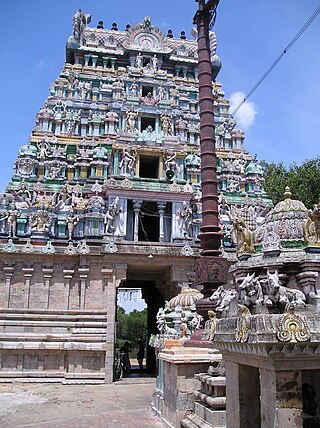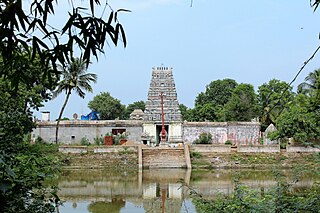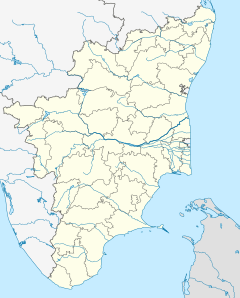
Arulmigu Murugan Temple, Thiruparankundram is a Hindu temple dedicated to the god Murugan at Thiruparankundram, Tamilnadu, India. It is regarded as one of the "First Houses of Murugan". The temple uses rock-cut architecture and is believed to have been built by the Pandyas during the 6th century. According to legend, Murugan slayed the demon Surapadman and married his consort Devasena at the temple. Murugan is also said to have worshipped his father Shiva at the site as Parangirinathar.

Tiruvalithayam Tiruvallesvarar Temple is a temple dedicated to the Hindu deity Shiva, located at Padi, a north-western neighbourhood of Chennai, India. Shiva is worshiped as Tiruvalleswarar, and is represented by the lingam and his consort Parvati is depicted as Jagathambikai. The presiding deity is revered in the 7th-century Tamil Saiva canonical work, the Tevaram, written by Tamil poet saints known as the nayanars and classified as Paadal Petra Sthalam.

Edaganathar Temple is a Hindu temple dedicated to the deity Shiva, located in Thiruvedagam, a village in Madurai district in the South Indian state of Tamil Nadu. The temple is located on the banks of Vaigai River. Shiva is worshipped as Edaganathar, and is represented by the lingam. His consort Parvati is depicted as Visalakshi. The presiding deity is revered in the 7th century Tamil Saiva canonical work, the Tevaram, written by Tamil saint poets known as the nayanars and classified as Paadal Petra Sthalam.

Thirukutralam represents one of the five Pancha Sabhas of Nataraja - Chitra Sabhai. The five dance halls of Shiva are Chidambaram, Madurai, Thiruvalangadu, Tirunelveli and Kutralam. Kutralam is also known as Trikootaachalam.

Apatsahayesvarar Temple, Alangudi or Guru Sthalam or Tiru Irum Poolai is a Hindu temple dedicated to Shiva located in the Needamangalam Town near village of Alangudi in the Valangaiman taluk of Tiruvarur district, Tamil Nadu, India. Shiva is worshipped as Apathsahyesvarar, and is represented by the lingam. His consort Parvati is depicted as Elavarkuzhali. The presiding deity is revered in the 7th-century Tamil Saiva canonical work, the Tevaram, written by Tamil saint poets known as the Nayanmars and classified as Paadal Petra Sthalam.

Kandeeswarar Temple is a Hindu temple dedicated to the god Shiva located in Kandiyur also known as Thirukkandiyur or Tirukkandiyur, near Tiruvaiyaru, Tamil Nadu, India. Shiva is worshiped as Kandeeswarar, and is represented by the lingam and his consort Parvati is depicted as Mangalanayagi. The presiding deity is revered in the 7th century Tamil Saiva canonical work, the Tevaram, written by Tamil poet saints known as the nayanars and classified as Paadal Petra Sthalam. As per legends, Shiva is believed to have destroyed eight different demons and the eight Ashta Veeratanam temples are built signifying each of his victories in the war. The temple is one of the eight where Shiva is believed to have removed one of the five heads of Brahma.

Kalyanasundaresar Temple, Nallur or Thirunallur is a Hindu temple dedicated to the deity Shiva in Nallur, Tamil Nadu, India. It is located 10 km (6.2 mi) away from Kumbakonam, 6 km (3.7 mi) east of Thirukkarugavur, and 30 km (19 mi) south of Thanjavur.

Maanturai Amravaneswarar Temple, is a temple dedicated to Hindu deity Shiva, located in Manturai, a village in the outskirts of Trichy, in the South Indian state of Tamil Nadu. It is one of the 275 Paadal Petra Sthalams, where the three of the most revered Nayanars, Appar and Tirugnana Sambandar have glorified the temple with their verses during the 7th-8th century. The temple has been widely expanded by Chola kings during the 11th century. The temple has three tiered gateway tower and a tank. Since Shiva bestowed a deer with a mango, this place is called Manthurai.

Sivayoginathar Temple also known as Yoganandeswarar temple is a Hindu temple dedicated to Shiva located in is located in Thiruvisanallur in Thanjavur district, Tamil Nadu, India. Shiva is worshiped as Sivayoginathar, and is represented by the lingam and his consort Parvati is depicted as Mangala Nayagi. The presiding deity is revered in the 7th century Tamil Saiva canonical work, the Tevaram, written by Tamil poet saints known as the nayanars and classified as Paadal Petra Sthalam.

Sakshinatheswarar Temple or Thiruppurambiyam Temple is a Hindu temple dedicated to the God Shiva located in Thiruppurambiyam, Tamil Nadu, India. Shiva is worshipped as Sakshinathar, and is represented here by a Lingam. His consort, Parvati, is depicted as Ikshuvani. The presiding deity is revered in the 7th century Tamil Saiva canonical work, Thevaram, written by Tamil saint poets, known as the Nayanmaars and classified as Paadal Petra Sthalam.

Uma Maheswarar Temple of Konerirajapuram in the Mayiladuthurai district in the South Indian state of Tamil Nadu, is a historical temple dedicated to Shiva. Shiva is worshiped as Uma Maheswarar, and is represented by the lingam and his consort Parvati is depicted as Mattuvar Kuzhalammai. The presiding deity is revered in the 7th century Tamil Saiva canonical work, the Tevaram, written by Tamil saint poets known as the nayanars and classified as Paadal Petra Sthalam.

Tiruneelakkudi Neelakandeswarar Temple is a Hindu temple located at Thanjavur district of Tamil Nadu, India. The historical name of Tiruneelakkudi is Thennalakudi. The presiding deity is Shiva. He is called as Neelakandeswarar. His consort is Oppilamulaiyal.

Innambur Ezhutharinathar Temple is a Hindu temple dedicated to Shiva, located in Innambur, a village in the outskirts of Kumbakonam, in Thanjavur district in Tamil Nadu, India. Shiva is worshipped as Ezhutharinathar and his consort Parvati as Nithya Kalyani. Ona Kantheeswarar is revered in the 7th century Tamil Saiva canonical work, the Tevaram, written by Tamil saint poets known as the Nayanars and classified as Paadal Petra Sthalam, the 275 temples revered in the canon.

Kripapureeswarar Temple in Thiruvennainallur, a panchayat town in Villupuram district in the South Indian state of Tamil Nadu, is dedicated to the Hindu god Shiva. The presiding deity is revered in the 7th century Tamil Saiva canonical work, the Tevaram, written by Tamil saint poets known as the Nayanmars and classified as Paadal Petra Sthalam. The temple is closely associated with Sundarar, the saivite saint of the 8th century, who started composing his Tirumurai starting with "Pitha Piraisudi" verse in this temple.

Thirumuruganatheeswarar Temple in Thirumuruganpoondi, a panchayat town in Tiruppur district in the South Indian state of Tamil Nadu, is dedicated to the Hindu god Shiva. Constructed in the Dravidian style of architecture, the present structure of the temple is believed to have been built during the Kongu Cholas period in the 10th century. Shiva is worshipped as Thirumuruganatheeswarar and his consort Parvathi as Avudainayagi.

Marundeeswarar Temple or Oushadheeshwar Temple is a Hindu temple dedicated to the deity Shiva. Shiva is worshipped as Marundeeswarar, and is represented by the lingam. His consort Sati is depicted as Anjanakshi. The presiding deity is associated with the 7th century Tamil Saiva Nayanars Sundarar. The temple is counted as a twin temple along with Kachabeswarar temple, the place where Lord Vishnu did penances to Lord Shiva to incarnate into his Kachaba (Tortoise) Avatar.

Kachabeswarar Temple, Thirukachur is a Hindu temple dedicated to the deity Shiva, located in Thirukachur, a village in Kanchipuram district in the South Indian state of Tamil Nadu. Shiva is worshipped as Kachabeswarar, and is represented by the lingam. His consort Parvati is depicted as Antanatchi and Kanniyumaiyal. The presiding deity is revered in the 7th-century CE Tamil Saiva canonical work, the Tevaram, written by Tamil saint poets known as the Nayanars and classified as Paadal Petra Sthalam. The temple is counted as a twin temple along with Marundeeswarar Temple located in the same village.

Thirukumaresar Temple is a Hindu temple dedicated to the deity Shiva, located in a ' RAJENDIRAPATTINAM ' also refer as 'YAZHPANAMPATTINAM' or ' ERUKATHAMPULIYUR ' is a village in Cuddalore district in the South Indian state of Tamil Nadu. Shiva is worshipped as Thirukumaresar, and is represented by the lingam. His consort Parvati is depicted as Verumulai Amman. The presiding deity is revered in the 7th century Tamil Saiva canonical work, the Tevaram, written by Tamil saint poets known as the Nayanars and classified as Paadal Petra Sthalam. The temple is also the birthplace of Saiva saint Tirunilakanta Nayanar

Pushpavaneswarar temple in Thirupuvanam, a town in Sivaganga district in the South Indian state of Tamil Nadu, is dedicated to the Hindu god Shiva. Constructed in the Dravidian style of architecture, the temple is believed to have been built during the Cholas period in the 7th century. Shiva is worshipped as Pushpavaneswarar and his consort Parvathi as Soundaranayagi.

Veerateeswarar Temple is a Hindu temple located at Korukkai in Mayiladuthurai district of Tamil Nadu, India. The presiding deity is Shiva in the form of Veerateswarar and his consort is known as Gnanambigai. The presiding deity is revered in the 7th century Tamil Saiva canonical work, the Tevaram, written by Tamil saint poets known as the nayanars and classified as Paadal Petra Sthalam, the 276 temples that find mention in it.


























